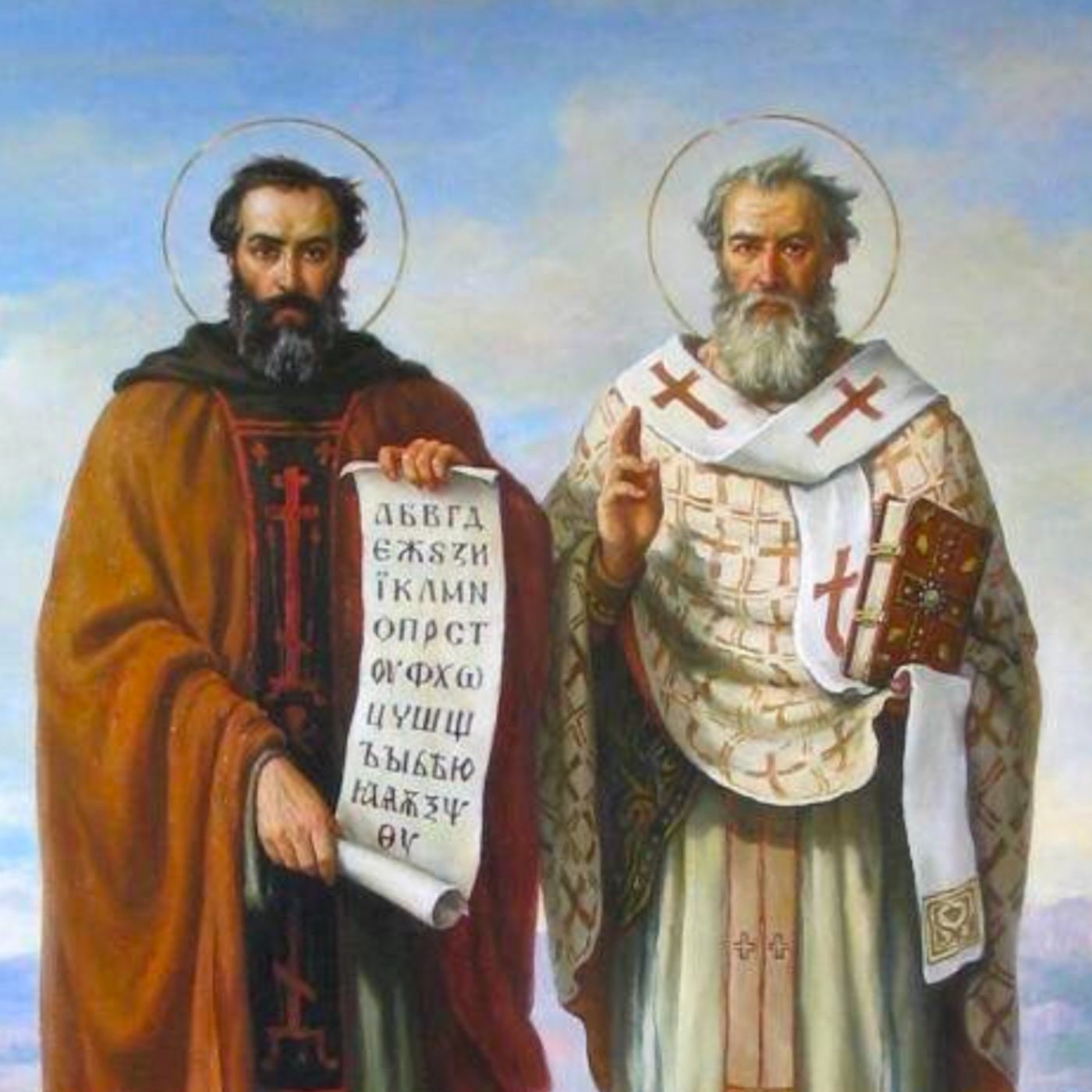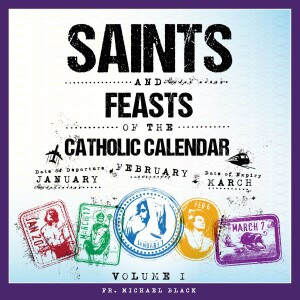
February 14: Saints Cyril, Monk, and Methodius, Bishop
 2024-02-11
2024-02-11
Download
Right click and do "save link as"
February 14: Saints Cyril, Monk, and Methodius, Bishop
St. Cyril: 827–869; St. Methodius: 815–884
Memorial; Liturgical Color: White
(When Lenten Weekday, Optional Memorial; Violet)
Co-Patrons of Europe and Apostles to the Slavs
Two makers of Europe light the flame of Eastern Christianity
The Cyrillic alphabet, used by hundreds of millions of people in Eastern Europe, the Balkans, and Russia, is named after today’s Cyril. Numerous proofs could be advanced for why a certain person is historically significant. Few proofs, however, can eclipse an alphabet being named after you. The evangelical labors of Cyril and Methodius were so path breaking, long lasting, and culture forming that these brothers stand in the very first rank of the Church’s greatest missionaries. Shoulder to shoulder with brave men such as Patrick, Augustine of Canterbury, Boniface, Ansgar, and others, they baptized nations, mustered clans from the forests, codified laws, transcribed alphabets, and transformed the crude pagan gropings for the divine into the transcendent worship of the one true God at Mass. Saints Cyril and Methodius helped form the religiously undivided reality of Christendom long before it was ever called Europe.
Cyril was baptized as Constantine and was known by that name until late in his life. He and Methodius were from Thessalonica, in Northern Greece, where they spoke not only Greek but also Slavonic, a critical linguistic advantage for their later missionary adventures. Cyril and Methodius received excellent educations in their youth and, as they matured, were given important educational, religious, and political appointments in an age when those disciplines were braided into one sturdy cord. The people, the state, and the Church were an undivided whole. Cyril and Methodius served the imperial court, the one true Church, and their native land as professors, governors, abbots, deacons, priests, and bishops.
Sometime after 860, the brothers were commissioned by the Emperor in Constantinople to lead a missionary crew heading into Moravia, in today’s Czech Republic. They walked straight into a tangled web of political, religious, linguistic, and liturgical controversies which have vexed Eastern and Central Europe until today. The Church of Rome allowed only three languages to be used in its liturgical and scriptural texts—Hebrew, Greek, and Latin—the three languages inscribed above Christ’s head on the cross. The Church in the East, juridically under Rome but culturally spinning off into its own orbit over the centuries, was a patchwork of peoples where local vernaculars were used in the liturgy. Languages are always spoken long before they are written, and the spoken Slavonic of Moravia had unique sounds demanding new letters populating a new alphabet. Cyril created that new alphabet, and then he and Methodius translated Scripture, various liturgical books, and the Mass into written Slavonic. This led to some serious tensions.
The newly Christianized German bishops were suspicious of missionaries in their own neighborhood who came from Greece, spoke Slavonic, and who celebrated the sacred mysteries in a quasi-Byzantine style. Moravia and the greater Slavic homeland were under German ecclesiastical jurisdiction, not Greek. How could the Mass be said in Slavonic, or the Gospels translated into that new language? How could a Byzantine liturgy co-exist with the Latin rite? Cyril and Methodius went to Rome to resolve these various issues with the Pope and his advisers.
The brothers were treated respectfully in Rome as well-educated and heroic missionaries. Cyril died and was buried in the Eternal City. Methodius returned to the land of the Slavs and to ongoing tensions with German ecclesiastics and princes. He translated virtually the entire Bible into Slavonic, assembled a code of Byzantine church and civil law, and firmly established, with the Pope’s permission, the use of Slavonic in the liturgy. After Methodius’ death, however, German and Latin Rite influences prevailed. The Byzantine Rite, the use of Slavonic in the liturgy, and the Cyrillic alphabet were all forced from Central to Eastern Europe, particularly into Bulgaria, shortly after Methodius died.
While they were always honored in the East, the Feast of SS. Cyril and Methodius was extended to the entire Catholic Church only in 1880. Pope Saint John Paul II named Saints Cyril and Methodius Co-Patrons of Europe. Their massive legacy inspires the two lungs of the Church, both East and West, to breathe more deeply the enriched oxygen of the entire Christian tradition.
Saints Cyril and Methodius, you prepared yourselves for brave and generous service to Christ and His Church through long years of preparation and, when the time came, you served heroically. May we so prepare, and so serve, until we can serve no more.
view more
St. Cyril: 827–869; St. Methodius: 815–884
Memorial; Liturgical Color: White
(When Lenten Weekday, Optional Memorial; Violet)
Co-Patrons of Europe and Apostles to the Slavs
Two makers of Europe light the flame of Eastern Christianity
The Cyrillic alphabet, used by hundreds of millions of people in Eastern Europe, the Balkans, and Russia, is named after today’s Cyril. Numerous proofs could be advanced for why a certain person is historically significant. Few proofs, however, can eclipse an alphabet being named after you. The evangelical labors of Cyril and Methodius were so path breaking, long lasting, and culture forming that these brothers stand in the very first rank of the Church’s greatest missionaries. Shoulder to shoulder with brave men such as Patrick, Augustine of Canterbury, Boniface, Ansgar, and others, they baptized nations, mustered clans from the forests, codified laws, transcribed alphabets, and transformed the crude pagan gropings for the divine into the transcendent worship of the one true God at Mass. Saints Cyril and Methodius helped form the religiously undivided reality of Christendom long before it was ever called Europe.
Cyril was baptized as Constantine and was known by that name until late in his life. He and Methodius were from Thessalonica, in Northern Greece, where they spoke not only Greek but also Slavonic, a critical linguistic advantage for their later missionary adventures. Cyril and Methodius received excellent educations in their youth and, as they matured, were given important educational, religious, and political appointments in an age when those disciplines were braided into one sturdy cord. The people, the state, and the Church were an undivided whole. Cyril and Methodius served the imperial court, the one true Church, and their native land as professors, governors, abbots, deacons, priests, and bishops.
Sometime after 860, the brothers were commissioned by the Emperor in Constantinople to lead a missionary crew heading into Moravia, in today’s Czech Republic. They walked straight into a tangled web of political, religious, linguistic, and liturgical controversies which have vexed Eastern and Central Europe until today. The Church of Rome allowed only three languages to be used in its liturgical and scriptural texts—Hebrew, Greek, and Latin—the three languages inscribed above Christ’s head on the cross. The Church in the East, juridically under Rome but culturally spinning off into its own orbit over the centuries, was a patchwork of peoples where local vernaculars were used in the liturgy. Languages are always spoken long before they are written, and the spoken Slavonic of Moravia had unique sounds demanding new letters populating a new alphabet. Cyril created that new alphabet, and then he and Methodius translated Scripture, various liturgical books, and the Mass into written Slavonic. This led to some serious tensions.
The newly Christianized German bishops were suspicious of missionaries in their own neighborhood who came from Greece, spoke Slavonic, and who celebrated the sacred mysteries in a quasi-Byzantine style. Moravia and the greater Slavic homeland were under German ecclesiastical jurisdiction, not Greek. How could the Mass be said in Slavonic, or the Gospels translated into that new language? How could a Byzantine liturgy co-exist with the Latin rite? Cyril and Methodius went to Rome to resolve these various issues with the Pope and his advisers.
The brothers were treated respectfully in Rome as well-educated and heroic missionaries. Cyril died and was buried in the Eternal City. Methodius returned to the land of the Slavs and to ongoing tensions with German ecclesiastics and princes. He translated virtually the entire Bible into Slavonic, assembled a code of Byzantine church and civil law, and firmly established, with the Pope’s permission, the use of Slavonic in the liturgy. After Methodius’ death, however, German and Latin Rite influences prevailed. The Byzantine Rite, the use of Slavonic in the liturgy, and the Cyrillic alphabet were all forced from Central to Eastern Europe, particularly into Bulgaria, shortly after Methodius died.
While they were always honored in the East, the Feast of SS. Cyril and Methodius was extended to the entire Catholic Church only in 1880. Pope Saint John Paul II named Saints Cyril and Methodius Co-Patrons of Europe. Their massive legacy inspires the two lungs of the Church, both East and West, to breathe more deeply the enriched oxygen of the entire Christian tradition.
Saints Cyril and Methodius, you prepared yourselves for brave and generous service to Christ and His Church through long years of preparation and, when the time came, you served heroically. May we so prepare, and so serve, until we can serve no more.
More Episodes
February 22: Chair of Saint Peter, Apostle
 2024-02-22
2024-02-22
 2024-02-22
2024-02-22
Ash Wednesday
 2024-02-13
2024-02-13
 2024-02-13
2024-02-13
February 11: Our Lady of Lourdes
 2024-02-10
2024-02-10
 2024-02-10
2024-02-10
February 10: Saint Scholastica, Virgin
 2024-02-09
2024-02-09
 2024-02-09
2024-02-09
February 8: Saint Jerome Emiliani, Priest
 2024-02-07
2024-02-07
 2024-02-07
2024-02-07
February 8: Saint Josephine Bakhita, Virgin
 2024-02-06
2024-02-06
 2024-02-06
2024-02-06
February 5: Saint Agatha, Virgin and Martyr
 2024-02-03
2024-02-03
 2024-02-03
2024-02-03
February 3: Saint Ansgar, Bishop
 2024-02-02
2024-02-02
 2024-02-02
2024-02-02
February 3: Saint Blaise, Bishop and Martyr
 2024-02-02
2024-02-02
 2024-02-02
2024-02-02
February 2: The Presentation of the Lord
 2024-01-31
2024-01-31
 2024-01-31
2024-01-31
January 31: Saint John Bosco, Priest
 2024-01-28
2024-01-28
 2024-01-28
2024-01-28
January 27: Saint Angela Merici, Virgin
 2024-01-26
2024-01-26
 2024-01-26
2024-01-26
01234568910111213141516171819
Create your
podcast in
minutes
- Full-featured podcast site
- Unlimited storage and bandwidth
- Comprehensive podcast stats
- Distribute to Apple Podcasts, Spotify, and more
- Make money with your podcast
It is Free
- Privacy Policy
- Cookie Policy
- Terms of Use
- Consent Preferences
- Copyright © 2015-2024 Podbean.com





